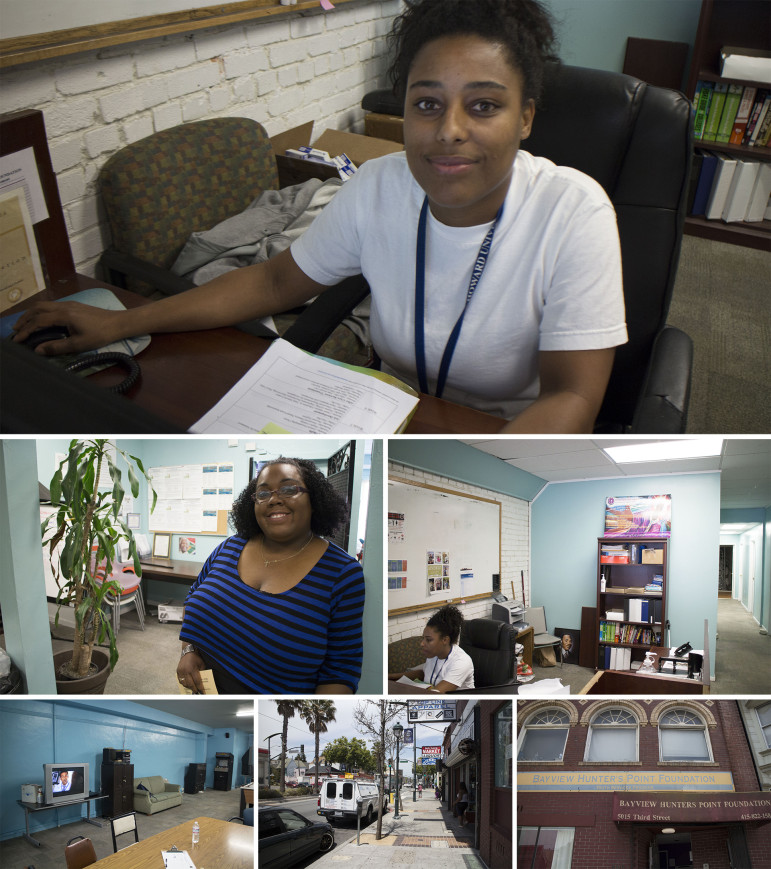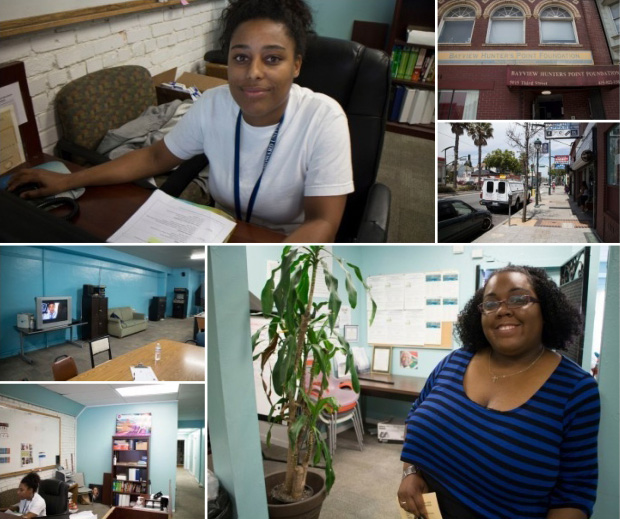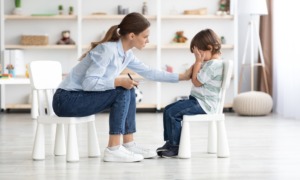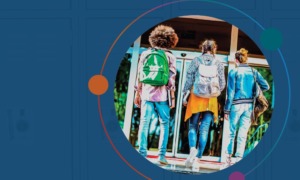
Sarah Zahedi
Top photo: Rachean Johnson sitting at the front desk of the Bayview Hunters Point Youth Foundation.
Middle-left: Counselor Julia Barboza has worked at the Bayview Hunters Point Youth Foundation for the past five years.
Middle-right: Rachean Johnson works as the administrative assistant at the Bayview Hunters Point Youth Foundation.
Bottom-left: Inside the recreational center at the Bayview Hunters Point Youth Foundation.
Bottom-middle and bottom-right: Outside of the Bayview Hunters Point Youth Foundation.
SAN FRANCISCO — At 12 years old, Rachean Johnson started smoking marijuana at least once every day.
“I just thought it was cool,” Johnson said. “I would see my friends smoking, so I did it too when I met up with them after school.”
Johnson was raised in the Bayview Hunters Point district of San Francisco. Thirty-nine percent of residents there are living below the census poverty threshold and median household income, according to the San Francisco Department of Public Health.
The neighborhood has also been distinguished by its higher rate of violence and health issues due to poor air and water quality, compared to all of San Francisco County.
Drug use was an easy habit to fall into young, living in this area, Johnson said.
“In this community there are a lot of ups and downs, a lot of struggles, a lot of hardships,” she said. “You get influenced and lost so easily when you see your friends going one way when you know you should be going another way.”
Around the same time Johnson began using marijuana, however, one of her friends told her about Bayview Hunters Point Youth Foundation, a walk-in recreational center that offers free counseling and substance abuse treatment for teens every weekday.
She began going to the center to hang out with friends from school and started to talk to a counselor about her drug use.
“It was a safe outlet for me to talk about the problems I was going through,” Johnson said. “I knew I wasn’t going to get in trouble because it was all confidential and not going to get back to my parents somehow.”
At the time, she did not feel comfortable talking about these issues with her parents.
“They were supportive but they were strict,” Johnson said. “It was easier to talk to a counselor because they were on the outside and they did not judge us.”
The foundation’s counseling services are part of its Youth Moving Forward program, which provides substance abuse treatment to people 13 to 17 years old including individual, group and family counseling. The program, funded by the city Department of Public Health, places a particular emphasis on the harm-reduction addiction treatment model, which focuses on preventing harm from drug overuse rather than on preventing drug use itself.
“Our goal is for them to reduce their use,” said counselor Julia Barboza. “So instead of [their] smoking five times, we say, ‘How about you do it four times?’ We meet them where they are at so to not have them totally quit but to reduce their use. In the process, they are not aware that they are actually going to stop.”
Johnson agreed she did not even know she was in a substance abuse treatment program when she was going to talk to her counselor.
“They don’t call it a drug treatment program. They just tell us that they are there for us to talk to,” Johnson said. “It was just a safe space and seeing it that way helped because it doesn’t scare you away.”
For this reason, youth services program director James McElroy said the counselors make it a point to avoid calling Youth Moving Forward a drug treatment program.
“We don’t want these youth to walk around thinking something is wrong with them if they decide to take part in our services,” he said. “We aren’t here to judge. We are here to help them achieve what they are trying to achieve in life.”
To do so, the program also makes a point of referring youth to social activities such as sports, exercise and field trips as an alternative to drug use.
“A lot of the times, the youth’s substance abuse problem comes from the kid not having anything else to do,” McElroy said. “We want to make sure we promote activities a youth is interested in so they can do something productive with their time at no cost.”
The program’s five counselors serve approximately 80 clients per year. Barboza said their success is due to the bond each counselor shares with the youth.
“We call them our kids versus our clients because they spend most of their time with us,” Barboza said. “At a lot of agencies, you don’t see that, kids just come in and out. Here, we do more than counsel kids and just sit in an office to help them reduce their use. We cook for them when they are hungry, we clothe them when they need clothes, we shelter them when they need shelter.”
Now that she has worked in the program for five years, Barboza said she sees the potential to grow and change in all the kids at the center.
“They all have goals they want to reach,” she said. “A lot of kids want a good job, to go to college, but there’s something that stops them from achieving those goals and that’s why we are here to help them.”
Counseling and social activity programs to combat substance abuse among youth, like Youth Moving Forward, are highly effective, said associate professor Dorian Traube at the University of Southern California’s School of Social Work. Traube, whose research is focused on promoting behavior and social functioning for high-risk populations of youth 13 to 24, said this is not only because these programs give kids an alternative activity to using drugs, but also because they provide a new social group.
“When they are presented with a new social group and doing activities they enjoy, they are less likely to return to a social group where substance use was prevalent,” she said.
Still, Traube said there is no one approach that will be perfect for every youth dealing with substance abuse issues.
“Treatments work effectively for different people depending on what prompted them to use substances and where they are emotionally and socially,” she said. “If an alternative social activity doesn’t work right away for a youth to stop using, it warrants further investigation into what exactly is perpetuating use and how best to stop it.”
Nonetheless, Traube said referring young people with substance abuse problems to counseling and social activity is never a bad idea.
For many youth like Rachean Johnson, it is these kinds of services that are the solution.
“Being in this program, I was distanced from the people I’d smoke and hang around with after school who were influencing me to smoke more,” Johnson said. “If I wasn’t able to come here, I would have been more into hanging in the streets and getting into trouble.”
Now 27, Johnson has never stopped visiting the center. Through middle school and high school, she regularly talked to counselors, and slowly decreased her marijuana use up until 18, when she aged out of the program. At 22, as a student of City College of San Francisco, she finally decided to quit smoking permanently.
“The decision was simple — it’s all about knowing what you want out of life,” Johnson said. “I knew I couldn’t reach my goals and be as successful in my life if I kept smoking.”
Today, working as the administrative assistant at the Bayview Hunters Point Youth Foundation, Johnson is also a part-time student at City College of San Francisco. Once she gets her associate’s degree, her next goal is to go to nursing school. Had she not had access to the Youth Moving Forward program, however, she said she would be a different person today.
“I would have been in jail by now … following the wrong friends, being guilty by association or something,” Johnson said. “This place changed my life completely.”
Hoping to see other youth achieve the same results, Johnson said she wants to see the center expand for years to come.
“It’s a pillar of the community and it’s a place where me and a lot of the other kids from this neighborhood grew up and are continuing to grow up,” Johnson said. “They welcome everyone with an open mind, open heart and open arms and that only helps people to do better with their lives.”
































